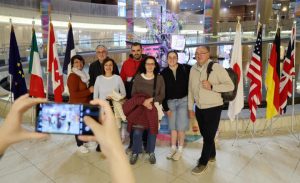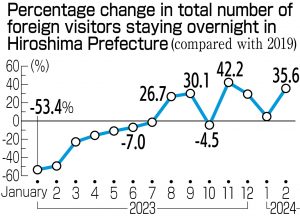One year after G7 Hiroshima Summit, achievements in question, Part 4: Economic effects
May 22, 2024
by Tomoyuki Kada and Masahiro Kurokawa, Staff Writers
Tailwind from summit leads to continued increases in overseas visitor numbers but limited effects on summit-related products, foods In the first floor lobby of the Grand Prince Hotel Hiroshima, located in the city’s Minami Ward, there are always overseas visitors taking commemorative photographs. Ever since it served as the main venue for the summit meeting of the G7 (Group of Seven industrialized nations) in May last year, the hotel has had on display the flags of the G7 countries and the European Union (EU).
In late April, Elena Gallard, 57, a visitor from Spain on a group tour, smiled as she explained how she had known that the G7 Summit was held in the hotel and how the view from the top floor and the manner of the hotel staff were wonderful in her estimation.
The number of guests staying at the hotel from January to April has recovered to nearly the same level as the same period in 2019, prior to the coronavirus pandemic. Haruo Hirase, general manager of the hotel, said with determination, “The response has exceeded our expectations. We want to live up to the expectations of our guests as the hotel that served as the main venue for the summit.”
The G7 Hiroshima Summit has become a tailwind for the recovery of the local economy, which had been hit hard by the pandemic. According to statistics from the national Japan Tourism Agency, the number of overseas visitors staying overnight in Hiroshima in 2023 totaled around 1.292 million people (preliminary figure), or 9.1 times that of the previous year. Although the figure in 2023 was 2.3 percent less than that in 2019, when broken down by month, the visitor number in November was 42.2 percent more than the same month in 2019, and 29.4 percent more in December. The weak yen also playing a part, the lodging industry continues to do well this year, with February’s figure up 35.6 percent.
OKOSTA, an okonomiyaki cooking studio in Hiroshima’s Minami Ward where British Prime Minister Rishi Sunak visited and had a try at cooking okonomiyaki while he was in Hiroshima, has also become increasingly popular among overseas tourists. In April this year, people from abroad accounted for more than 50 percent of all visitors, up from around 20 percent prior to the pandemic. The studio reported that the number of groups from the United Kingdom is also on the rise.
One year has passed since the summit was held in Hiroshima. While hotels and sightseeing spots have benefitted economically, the spillover effect has been limited for the popular products presented to the leaders of the participating countries and for the local ingredients used in the meals for entertaining the leaders.
Maruni Wood Industry, the company that produced the “Hiroshima Armchair” as seating for the summit leaders and is located in the city’s Saeki Ward, said that inquiries about their products increased following the summit but that there was no significant change in sales. However, the company is of the mindset that the summit provided an important opportunity for it to introduce its products to the world. Yasuyoshi Doi, a director at the company, expressed his expectations. “When looking over the long term, our brand value has increased. The next time people buy furniture, our products should be one of their options,” said Mr. Doi.
Efforts to capitalize on the increased attention on Hiroshima because of the summit must continue and ensure that the economic benefits are not temporary. One long-standing issue has been that many tourists visit Hiroshima on day trips but do not stay overnight. Strategies for attracting MICE events (meetings, incentives, conferences, and exhibitions) such as international conferences, fewer of which Hiroshima hosts than other officially designated cities in Japan, are required to make the most of effects from the Hiroshima Summit.
Koji Ikeda, chair of the Hiroshima Chamber of Commerce and Industry and vice chair of the Citizens Council for the Hiroshima Summit, urged, “Public- and private-sector organizations must work together to address such challenges as the creation of nighttime tourism spots, tours based out of Hiroshima of the Sanin and other areas, and the tourism business for the well-to-do.” The true value of such efforts for long-lasting effects will be put to the test.
(Originally published on May 22, 2024)
Tailwind from summit leads to continued increases in overseas visitor numbers but limited effects on summit-related products, foods In the first floor lobby of the Grand Prince Hotel Hiroshima, located in the city’s Minami Ward, there are always overseas visitors taking commemorative photographs. Ever since it served as the main venue for the summit meeting of the G7 (Group of Seven industrialized nations) in May last year, the hotel has had on display the flags of the G7 countries and the European Union (EU).
In late April, Elena Gallard, 57, a visitor from Spain on a group tour, smiled as she explained how she had known that the G7 Summit was held in the hotel and how the view from the top floor and the manner of the hotel staff were wonderful in her estimation.
The number of guests staying at the hotel from January to April has recovered to nearly the same level as the same period in 2019, prior to the coronavirus pandemic. Haruo Hirase, general manager of the hotel, said with determination, “The response has exceeded our expectations. We want to live up to the expectations of our guests as the hotel that served as the main venue for the summit.”
The G7 Hiroshima Summit has become a tailwind for the recovery of the local economy, which had been hit hard by the pandemic. According to statistics from the national Japan Tourism Agency, the number of overseas visitors staying overnight in Hiroshima in 2023 totaled around 1.292 million people (preliminary figure), or 9.1 times that of the previous year. Although the figure in 2023 was 2.3 percent less than that in 2019, when broken down by month, the visitor number in November was 42.2 percent more than the same month in 2019, and 29.4 percent more in December. The weak yen also playing a part, the lodging industry continues to do well this year, with February’s figure up 35.6 percent.
OKOSTA, an okonomiyaki cooking studio in Hiroshima’s Minami Ward where British Prime Minister Rishi Sunak visited and had a try at cooking okonomiyaki while he was in Hiroshima, has also become increasingly popular among overseas tourists. In April this year, people from abroad accounted for more than 50 percent of all visitors, up from around 20 percent prior to the pandemic. The studio reported that the number of groups from the United Kingdom is also on the rise.
One year has passed since the summit was held in Hiroshima. While hotels and sightseeing spots have benefitted economically, the spillover effect has been limited for the popular products presented to the leaders of the participating countries and for the local ingredients used in the meals for entertaining the leaders.
Maruni Wood Industry, the company that produced the “Hiroshima Armchair” as seating for the summit leaders and is located in the city’s Saeki Ward, said that inquiries about their products increased following the summit but that there was no significant change in sales. However, the company is of the mindset that the summit provided an important opportunity for it to introduce its products to the world. Yasuyoshi Doi, a director at the company, expressed his expectations. “When looking over the long term, our brand value has increased. The next time people buy furniture, our products should be one of their options,” said Mr. Doi.
Efforts to capitalize on the increased attention on Hiroshima because of the summit must continue and ensure that the economic benefits are not temporary. One long-standing issue has been that many tourists visit Hiroshima on day trips but do not stay overnight. Strategies for attracting MICE events (meetings, incentives, conferences, and exhibitions) such as international conferences, fewer of which Hiroshima hosts than other officially designated cities in Japan, are required to make the most of effects from the Hiroshima Summit.
Koji Ikeda, chair of the Hiroshima Chamber of Commerce and Industry and vice chair of the Citizens Council for the Hiroshima Summit, urged, “Public- and private-sector organizations must work together to address such challenges as the creation of nighttime tourism spots, tours based out of Hiroshima of the Sanin and other areas, and the tourism business for the well-to-do.” The true value of such efforts for long-lasting effects will be put to the test.
(Originally published on May 22, 2024)









